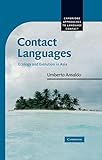Contact languages : ecology and evolution in Asia / Umberto Ansaldo.
Series: Cambridge approaches to language contactPublication details: Cambridge, UK : Cambridge University Press, 2009.Description: xvii, 257 p. : ill., maps ; 24 cmISBN:- 9780521863971 (hardback)
- 052186397X (hardback)
| Item type | Current library | Home library | Collection | Call number | Materials specified | Copy number | Status | Date due | Barcode | |
|---|---|---|---|---|---|---|---|---|---|---|
| AM | PERPUSTAKAAN TUN SERI LANANG | PERPUSTAKAAN TUN SERI LANANG KOLEKSI AM-P. TUN SERI LANANG (ARAS 5) | - | PM7831.A538 (Browse shelf(Opens below)) | 1 | Available | 00002076443 |
Includes bibliographical references and index.
Introduction to contact language formation (CLF) -- Research questions -- The role of ecology in Asian contexts -- Theory of language and CLF -- CLF beyond exceptional evolution -- Monsoon Asia -- Sino-Javanese trade -- The city-ports -- Manpower in Southeast Asia -- The Western impact -- Southeast Asia and the role of Mala -- Malay contact varieties -- Introducing contexts of formation -- The role of Portuguese in Southeast Asia and Southern China -- Summary -- The ideology of theory -- Multilingualism and transmission -- Conclusions -- Competence, performance and socialization -- Language evolution and contact languages --Functionalist assets for contact linguistics -- Conclusions -- The SLM community -- Selection and replication in SLM -- Freeing SLM from the chains of exceptionalism -- Final remarks -- The ecology of identity alignment -- Multiple alignments in contact settings -- Identity alignment and admixture -- Conclusions -- Sociohistorical background of Europe-China relations -- The ecology of Macau and the Pearl River Delta -- Grammatical features of China Coast Pidgin -- The missing Makista link? -- Discussion -- Theoretical and methodological implications -- Conclusions and new horizons.
'Why do groups of speakers in certain times and places come up with new varieties of languages? What are the social settings that determine whether a mixed language, a pidgin or a Creole will develop, and how can we understand the ways in which different languages contribute to the new grammar? Through the study of Malay contact varieties such as Baba Malay, Cocos Malay and Sri Lanka Malay, as well as the Asian Portuguese vernacular of Macau, and China Coast Pidgin, the book explores the social and structural dynamics that underlie the fascinating phenomenon of the creation of new, or restructured, grammars. It emphasizes the importance and interplay of historical documentation, socio-cultural observation and linguistic analysis in the study of contact languages, offering an evolutionary framework for the study of contact language formation - including pidgins and Creoles - in which historical, socio-cultural and typological observations come together'--Provided by publisher.
There are no comments on this title.

